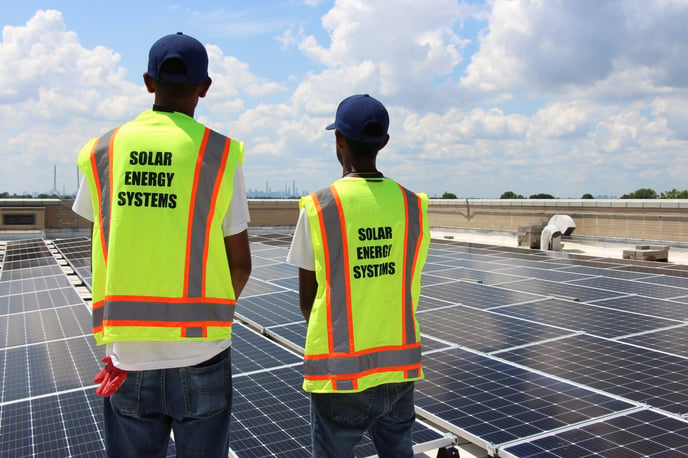The New York City Department of Education is training students on solar PV installation and offering internships for students to install solar on NYC DOE schools, spreading the benefits of solar to even more students across the city.
New York City aims to be carbon neutral by 2050. As part of this ambitious plan, buildings operated by the City of New York will house 100 MW of solar by 2025 — that’s enough clean electricity to power about 15,000 homes annually. With nearly 1,400 facilities spread across the five boroughs, the New York City Department of Education (NYC DOE) public schools will host the largest share of these solar installations.
NYC DOE, the largest school system in the nation, promptly recognized the unique opportunity presented by the city’s solar commitment to help prepare its 1.1 million students for a future powered by clean energy. With more than 250 solar installations either completed or underway at public schools, NYC DOE and its partners leveraged these projects to provide STEM learning and vocational training opportunities to students.
In 2016, the NYC DOE Office of Sustainability partnered with Solar One, a nonprofit energy and sustainability education organization, to design and deliver the NYC Solar Schools Education Program. Through this program, Solar One trains NYC DOE teachers on how to deliver self-guided, inquiry-based learning that builds STEM, engineering and problem-solving skills in alignment with established standards.
Over 1,000 K-12 teachers have participated in the program to-date and have
been given lessons on solar energy, energy efficiency and energy storage; kits with motors, lights, multimeters and solar panels for class activities; a toolbox of activities broken down for different age groups; and continuing education credits to help maintain professional certifications.
 Teachers also learn how to use solar energy production data in classroom lessons focused on data analysis and weather patterns. These lessons and all of the NYC Solar Schools Education Program activities provide a critical platform for learning about climate change and renewable energy that tie to many topics in the existing curriculum.
Teachers also learn how to use solar energy production data in classroom lessons focused on data analysis and weather patterns. These lessons and all of the NYC Solar Schools Education Program activities provide a critical platform for learning about climate change and renewable energy that tie to many topics in the existing curriculum.
The program also features technical training for students at NYC DOE Career and Technical Education (CTE) high schools. Students at 13 CTE high schools receive hands-on, skill building training in solar installation and attend a Solar Career Expo where they engage directly with solar industry professionals. The Expo gives students a sense of the diversity of roles available in the industry and an opportunity to make job connections. To-date, almost 1,000 CTE students have received technical solar training and exposure to career opportunities in this high demand field. Coming full circle with the program, the NYC DOE and Solar One organize student internships with solar companies that are installing solar on public schools. For these students, the school system where they learned about solar also becomes the place they work on their first solar installations as paid interns. Students garner the educational and financial benefits of the program while having an opportunity to bring solar energy to more NYC schools.As one teacher explained, “Our school is moving our curricula towards project-based learning, and this is perfect for incorporating interdisciplinary learning and activities around topics like sustainability, renewable resources and climate change.”
The NYC DOE Office of Sustainability and its partners have heard the call to action voiced by students and believe that connecting clean energy investments to classroom learning will inform and empower the next generation of environmental stewards.As Lucia, a student at Queens Technical High School in NYC, put it, “Solar jobs are the future. There are so many problems with the environment and global warming that will affect our future. We need to make the earth better.”
Last Updated: 6/9/2023

Generation180 has toolkits, guides, reports, and more to help your school go solar. Visit SolarForAllSchools.org for even more resources.
Want more about where this came from? Download our Brighter Future 2020 Report.
